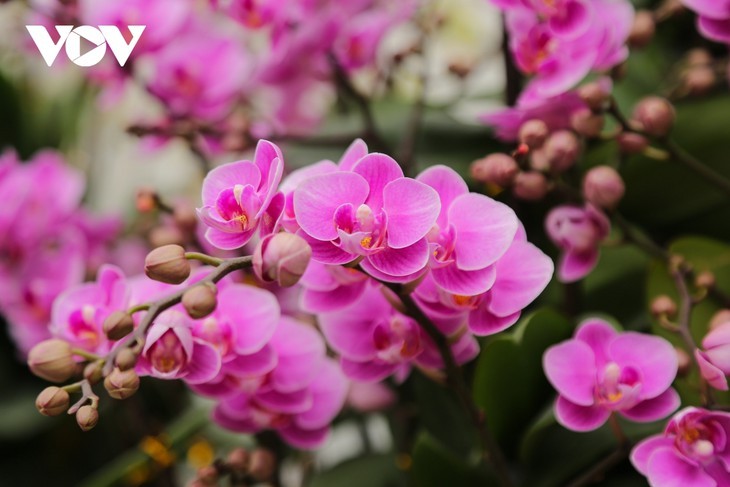 Orchid displays are much sought after during Tet by many Vietnamese customers Orchid displays are much sought after during Tet by many Vietnamese customers |
B: Most of the more than 350 letters and emails that we received from 35 countries and territories contain greetings for Vietnam’s upcoming traditional lunar new year festival or Tet, which will fall on February 1st this year.
A: Jose Saquimux of Guatemala wrote: “I wish you a New year of happiness and fun. From Guatemala, I send you wishes with love and respect.”
B: Johnny Antonio Ramírez López of Lima, Peru wrote: “VOV has brought me lessons and valuable experiences. I enjoy the programs a lot. Let’s toast to celebrate the New Year. I wish VOV journalists and technicians and broadcasters around the world all the best in the New Year 2022.”
A: Héctor Gregorio Goicoechea of Uruguay wrote: “It’s not easy to listen to VOV in my area. But I always try to get VOV signals because your programs bring me closer to Vietnam, a country that I love a lot.”
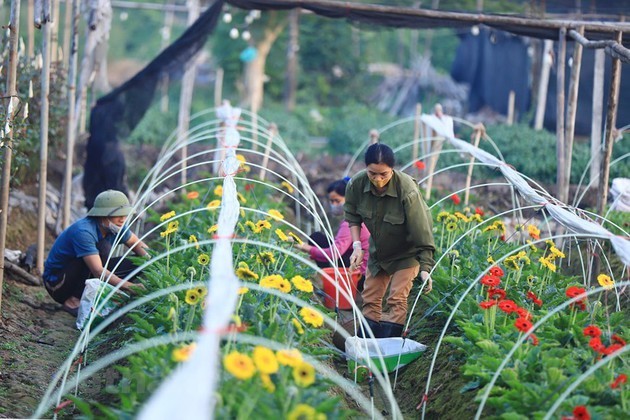 Lilies, roses, and chrysanthemums are among the popular flowers grown in Tay Tuu village to serve demand of the traditional lunar New Year Lilies, roses, and chrysanthemums are among the popular flowers grown in Tay Tuu village to serve demand of the traditional lunar New Year |
B: Last week, Professor Jonathan Van-Tam, Deputy Chief Medical Officer for England, was knighted by Queen Elizabeth II of the UK for his contributions to the local fight against COVID-19.
A: Jonathan Van-Tam, an Englishman of Vietnamese origin, was one of those receiving a Knighthood in the New Year's Honours list, which also included England’s chief medical officer Professor Chris Whitty.
B: Commenting on this story, Juan Diez of Spain wrote: “Even the Queen of the UK recognized contributions of Professor Jonathan Van-Tam, who makes Vietnam better known in the UK and raises Vietnam’s international status. Vietnam’s professionalism and good training have been internationally recognized.”
A: Vilayvan of Laos and many other listeners want to know about the implementation of vaccine passports in Vietnam.
B: The Ministry of Health has announced procedures for the issuance of Vietnam’s official COVID-19 'vaccine passports’ along with passport templates.
A: The COVID-19 vaccine certificates are to be issued for people who have received the primary course of one of eight types of COVID-19 vaccines licensed for use in Vietnam by the health ministry, namely AstraZeneca’s Vaxzevria, Gamaleya Research Institute’s Sputnik V, Sinopharm’s Vero Cell Inactivated along with the manufactured-in-UAE version Hayat-Vax, Pfizer/BioNTech’s Comirnaty, Moderna’s Spikevax, Johnson & Johnson’s Janssen, and Cuba Centre for Genetic Engineering and Biotechnology (CIGB)’s Abdala. The QR code-based passport will be valid for 12 months.
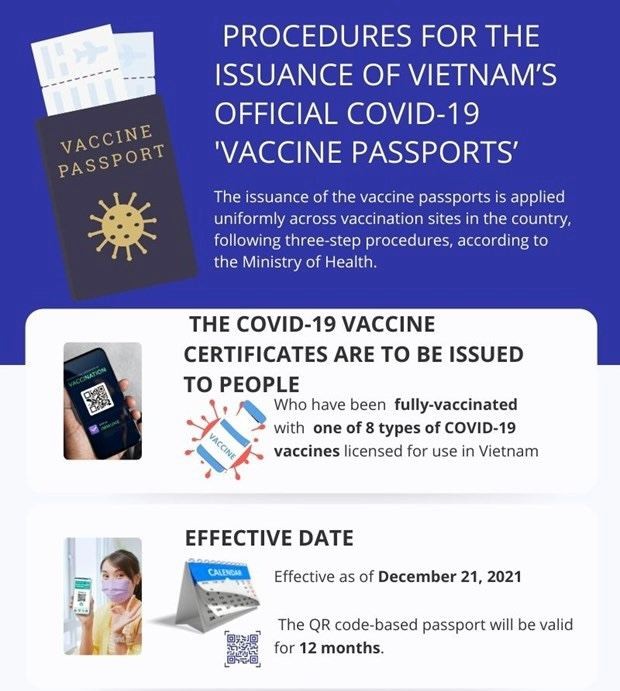 The Ministry of Health announced procedures for the issuance of Vietnam’s official COVID-19 'vaccine passports’ along with passport templates The Ministry of Health announced procedures for the issuance of Vietnam’s official COVID-19 'vaccine passports’ along with passport templates |
B: Five countries – the United States, Japan, Australia, the United Kingdom, and Belarus – have recognised Vietnam’s COVID-19 vaccination certificates with specific criteria on the vaccine types.
A: 80 other partners, including India and Canada, have agreed in principle with the recognition, while ASEAN countries, the European Union, China and South Korea are finishing the final procedures.
B: Meanwhile, seven countries and territories - the US, Japan, Singapore, Cambodia, Thailand, Taiwan (China) and South Korea - have basically agreed with Vietnam's proposal on a plan to resume regular international routes, according to the Civil Aviation Authority of Vietnam (CAAV).
A: Statistics from the authority show that in the first seven days after re-operating regular international flights from January 1, there were a total of 64 flights carrying more than 7,800 passengers to Vietnam.
B: By Tuesday, Vietnam had injected over 162 million doses of vaccines, with more than 71 million people now fully inoculated, while nearly 13 million third shots, either booster shots or the third shot of Abdala vaccine, had been administered.
A: With this update, we hope we have answered Kim Layheang of Cambodia who was interested to know about Vietnam’s COVID-19 vaccinations.
B: This week, Shouji Satoshi of Japan asked about wood carving art in Vietnam.
A: Wood carving is a cultural heritage that has been passed down from one generation to another in Vietnam. Hand-carved products represent sophisticated features of the villages.
B: Let’s explore the art on a trip to 300-year-old Dong Giao village in Hai Duong province, 45 kilometers east of Hanoi.
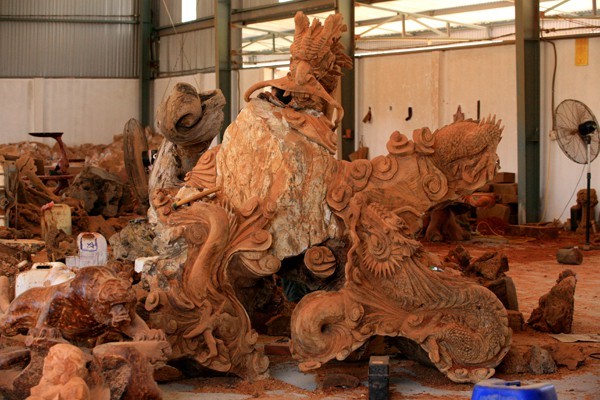 Dong Giao wood product (Photo: quehuongonline.vn) Dong Giao wood product (Photo: quehuongonline.vn) |
A: At the entrance to the village, visitors can smell the wood and paint and hear bustling sounds of chiseling, and sawing, all contributing to the strikingly different impression Dong Giao makes compared to the tranquility that is often associated with a rural town.
B: According to village records, the wood carving craft began in the 17th century. The forefather of the craft was a man of Vu clan, of which many served as mandarins to the feudal dynasties. The Vu clan also had skilled carvers who were sent to Hue, the former capital of Vietnam, to serve the royals, spreading the fame of Dong Giao craftmen.
A: Dong Giao wood carving village used to excel at producing objects of worship and ritual furniture such as thrones, incense tables, couches, and statues. Nowadays, customers are in more favor of decorative items, including the three statues of happiness, prosperity, and longevity, the Maitreya, and animals representing happiness and luck.
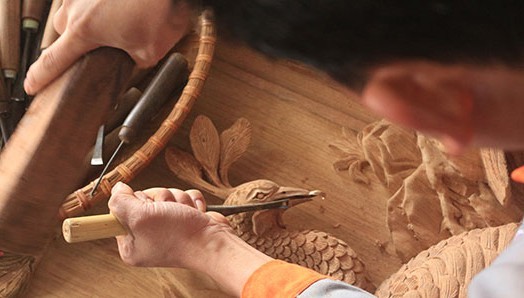 Each product is intricately carved (Photo: quehuongonline.vn) Each product is intricately carved (Photo: quehuongonline.vn) |
B: The carving process demands considerable sophistication, dexterity, and attention to such minute details as how to arrange the wood grains. The products embrace not only individual creativity but also the cultural traditions of Dong Giao village.
A: Dong Giao products have been exported to overseas markets, including China, Europe, and ASEAN.
B: Over the past week, we received several emails and feedback from Mrityunjoy Bera of India. He wrote: “Many thanks for your interesting programs. Specially news, editorials, cultural and sports presentations. The reception quality of your service is good. The website is so much beautiful. Wishes a Happy New Year 2022 to all of you.”
A: Welcome back to VOV Mr. Bera. We’re happy to receive several feedback from you over the past week. We will send you our program frequency list and schedule to make it easier for you to listen to our programs. VOV English programs are also available on our website at vovworld.vn and our VOV Media App which can be found on both iOs and Android platforms. We hope to receive more feedback from you.
B: Next, we’d like to confirm a reception report from MD. Abdul Mannan of Bangladesh who listened to our program from 16:00 to 16:30 on January 8 on the frequency of 7220 khz. He wrote: “I’m a regular listener of your English program. I listen to your program every day. Good signal and clear sound when I heard your program.”
A: Now we’d like to acknowledge emails and letters from Abdul Aleem, Ratan Kumar Paul, and Prithwiraj Purkayastha of India and other listeners who posted comments on our Facebook page with New Year greetings and feedback on our programs.
B: That concludes today’s program. We welcome your feedback at: English Service, VOVworld, the Voice of Vietnam, 45 Ba Trieu street, Hanoi, Vietnam. Or you can email us at: englishsection@vov.vn. You’re invited to visit us online at vovworld.vn, where you can hear both live and recorded programs.
A: Check out our VOV Media App, and VOV Live available on both the IOS and Android platform to hear our live broadcasts. We look forward to your feedback on the mobile version of vovworld.vn. Once again, thank you all for listening. Goodbye.